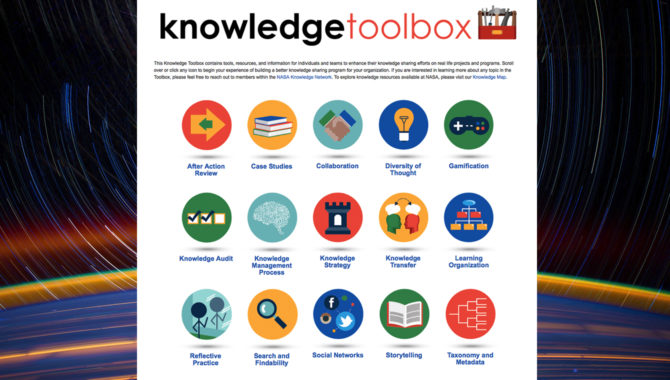In 2016 NASA published their toolbox for KM. Here's what is in it.
 |
| See NASA source page |
NASA APPEL introduced their new organisation-wide HQ KM toolbox at the beginning of 2016, under the heading "a new toolbox for a new year". You can find further details of each tool via this page, with the common elements of the KM toolbox being listed as "HQ" items. These tools are a mixture if processes and concepts. Individual NASA centres have additional tools which are not in the HQ toolbox.
The text below is largely NASA's headline description, with some commentary from me.
After Action Review needs no introduction for readers of this blog. It is the default small-team process for learning from experience. The process has been adapted from the U.S. Army’s “AAR” to become NASA’s “Pause and Learn” methodology popularized by the Chief Knowledge Officer at Goddard Space Flight Center.
Case studies are a great way of encapsulating knowledge from past missions.
Collaboration enables individuals to work together to achieve a defined and
common business purpose
Diversity of Thought (or Multiple Perspectives) is an effective approach used to obtain opinions, identify weaknesses in concepts, improve on ideas, and brainstorm new possibilities
Gamification is the use of game mechanics and game design techniques in non-game contexts.>
Knowledge Audit is an assessment of an organization’s knowledge capabilities. It identifies the gap between available knowledge and what’s needed based on the organization’s strategic objectives. Knoco offers a knowledge audit service.
Knowledge Management Process. The Knowledge Management Process is the architecture used to acquire and benefit from knowledge resources and capabilities. What we in Knoco would call a KM Framework.
Knowledge Strategy. A Knowledge Strategy (for NASA organisations) specifies how specific knowledge services will be implemented to bridge the gap between an organization’s current knowledge capabilities and the capabilities needed to accomplish its strategic objectives.
Knowledge Transfer for NASA is described as the ability to efficiently locate existing knowledge and get it to where it is needed.
Learning organisation is one that acquires knowledge and innovates fast enough to survive and thrive in a rapidly changing environment by embracing characteristics that encourage, support and promote participation.
Reflective practice refers to learning from experience when observing one’s own action, thoughts or feelings; and utilizing these observations in building new understandings.
Search and Findability.
As the ability to search and find relevant information has become more challenging and complex, when developing information architecture to enhance the search and findability experience, it is important to consider that unstructured information is growing at an astounding rate. As a result, there is a negative impact on findability.
Social networks are relations among people who share interests, activities, backgrounds or real-life connections (i.e., work, community, or groups).
Storytelling One of the most powerful ways to make your point memorable or to persuade people is by telling a compelling story that unites an idea with emotions.
There is also an addition to the HQ toolbox since 2016, which is the KM Plan.
KM Plans. NASA NPD and NPR have requirements for Knowledge Management (KM) Plans within a Project Plan




No comments:
Post a Comment